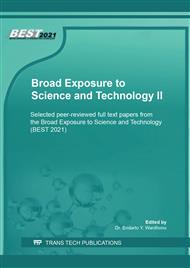[1]
Yudhanto F., and Heru SB Rochardjo, Application of taguchi method for selection parameter bleaching treatments against mechanical and physical properties of agave cantala fiber, IOP Conference Series: Mater. Sci. and Eng. Vol. 352. No. 1. IOP Publishing, (2018).
DOI: 10.1088/1757-899x/352/1/012002
Google Scholar
[2]
Listyanda, R.F., Kusmono, Wildan, M.W. and Ilman, M.N., Extraction and characterization of nanocrystalline cellulose (NCC) from ramie fiber by sulphuric acid hydrolysis, AIP Conf. Proc. Vol. 2217. No. 1. AIP Publishing LLC, (2020).
DOI: 10.1063/5.0001068
Google Scholar
[3]
Reddy, J.P. and Rhim, J.W., Characterization of bionanocomposite films prepared with agar and paper-mulberry pulp nanocellulose, Carb. Poly. 110 (2014): 480-488.
DOI: 10.1016/j.carbpol.2014.04.056
Google Scholar
[4]
Kusmono, K., A preliminary study of extraction and characterization of nanocrystalline cellulose (NCC) from ramie fiber, J. of Mater. Process. and Char. 1.1 (2020).
DOI: 10.22146/jmpc.51418
Google Scholar
[5]
Frone, A.N., Panaitescu, D.M., Donescu, D., Spataru, C.I., Radovici, C., Trusca, R. and Somoghi, R., Preparation and characterization of PVA composites with cellulose nanofibers obtained by ultrasonication, BioRes. 6.1 (2011): 487-512.
DOI: 10.15376/biores.6.1.487-512
Google Scholar
[6]
Fortunati, E., Puglia, D., Luzi, F., Santulli, C., Kenny, J.M. and Torre, L., Binary PVA bio-nanocomposites containing cellulose nanocrystals extracted from different natural sources: Part I." Carb. poly. 97.2 (2013): 825-836.
DOI: 10.1016/j.carbpol.2013.03.075
Google Scholar
[7]
Sultana, T., Sultana, S., Nur, H.P. and Khan, M.W., Studies on Mechanical, Thermal and Morphological Properties of Betel Nut Husk Nano Cellulose Reinforced Biodegradable Polymer Composites, Jour. of Comp. Sci. 4.3 (2020): 83.
DOI: 10.3390/jcs4030083
Google Scholar
[8]
Rochardjo, H.S., Fatkhurrohman, A.K. and Yudhanto, F., Fabrication of Nanofiltration Membrane based on Polyvinyl Alcohol Nanofibers Reinforced with Cellulose Nanocrystal using Electrospinning Techniques, Int. Jour. of Tech. 12, 2 (2021).
DOI: 10.14716/ijtech.v12i2.4173
Google Scholar
[9]
Yudhanto, F., Jamasri and Rochardjo, H.S.B., Physical and thermal properties of cellulose nanofibers (CNF) extracted from agave cantala fibers using chemical-ultrasonic treatment, Int. Rev.of Mech. Eng. 12 (2018): 597-603.
DOI: 10.15866/ireme.v12i7.14931
Google Scholar
[10]
French, A.D. and Cintrón, M.S., Cellulose polymorphy, crystallite size, and the Segal crystallinity index, Cellulose 20.1 (2013): 583-588.
DOI: 10.1007/s10570-012-9833-y
Google Scholar
[11]
Xie, J., Hse, C.Y., Cornelis, F., Hu, T., Qi, J. and Shupe, T.F., Isolation and characterization of cellulose nanofibers from bamboo using microwave liquefaction combined with chemical treatment and ultrasonication, Carb. Poly. 151 (2016): 725-734.
DOI: 10.1016/j.carbpol.2016.06.011
Google Scholar
[12]
Kargarzadeh, H., Ahmad, I., Abdullah, I., Dufresne, A., Zainudin, S.Y. and Sheltami, R.M., Effects of hydrolysis conditions on the morphology, crystallinity, and thermal stability of cellulose nanocrystals extracted from kenaf bast fibers, Cellulose 19.3 (2012): 855-866.
DOI: 10.1007/s10570-012-9684-6
Google Scholar
[13]
Fatkhurrohman, Rochardjo, H.S.B., Kusumaatmaja, A. and Yudhanto, F., Extraction and effect of vibration duration in ultrasonic process of cellulose nanocrystal (CNC) from ramie fiber, AIP Conf. Proc. Vol. 2262. No. 1. AIP Publishing LLC, (2020).
DOI: 10.1063/5.0015794
Google Scholar
[14]
Yang, Y.P., Zhang, Y., Lang, Y.X. and Yu, M.H., Structural ATR-IR analysis of cellulose fibers prepared from a NaOH complex aqueous solution, IOP conf. series: mat. Sci.and eng. Vol. 213. No. 1. IOP Publishing, (2017).
DOI: 10.1088/1757-899x/213/1/012039
Google Scholar
[15]
Yudhanto, F., Jamasri, J., Rochardjo, H. and Kusumaatmaja, A., Experimental Study of Polyvinyl Alcohol Nanocomposite Film Reinforced by Cellulose Nanofibers from Agave Cantala, Int. Jour. of Eng. 34.4 (2021): 987-998.
DOI: 10.5829/ije.2021.34.04a.25
Google Scholar
[16]
Yudhanto, F. and Rochardjo, H.S.B., Physical and Mechanical Characterization of Polyvinyl Alcohol Nanocomposite Made from Cellulose Nanofibers, Mater. Sci. For. Vol. 988. Trans Tech Publications Ltd, (2020).
DOI: 10.4028/www.scientific.net/msf.988.65
Google Scholar
[17]
Sosiati, H., Muhaimin, M.M., Wijayanti, D.A. and Triyana, K., Microscopic characterization of cellulose nanocrystals isolated from sisal fibers." Mater. Sci. For. Vol. 827. Trans Tech Publications Ltd, (2015).
DOI: 10.4028/www.scientific.net/msf.827.174
Google Scholar
[18]
Rosli, N.A., Ahmad, I. and Abdullah, I., Isolation and characterization of cellulose nanocrystals from Agave angustifolia fibre, BioRes. 8.2 (2013): 1893-1908.
DOI: 10.15376/biores.8.2.1893-1908
Google Scholar
[19]
Krishnadev, P., Subramanian, K.S., Janavi, G.J., Ganapathy, S. and Lakshmanan, A., Synthesis and Characterization of Nano-fibrillated Cellulose Derived from Green Agave americana L. Fiber." BioRes. 15.2 (2020): 2442-2458.
DOI: 10.15376/biores.15.2.2442-2458
Google Scholar
[20]
Das, M. and Chakraborty, D., Influence of alkali treatment on the fine structure and morphology of bamboo fibers, Jour. of App. Poly. Sci. 102.5 (2006): 5050-5056.
DOI: 10.1002/app.25105
Google Scholar
[21]
Kaushik, A., Singh, M. and Verma, G., Green nanocomposites based on thermoplastic starch and steam exploded cellulose nanofibrils from wheat straw, Carb. Poly. 82.2 (2010): 337-345.
DOI: 10.1016/j.carbpol.2010.04.063
Google Scholar
[22]
Yudha, V., Rochardjo, H.S.B., Jamasri, J., Widyorini, R., Yudhanto, F. and Darmanto, S., Isolation of cellulose from salacca midrib fibers by chemical treatments, IOP Conf. Series: Mat. Sci. and Eng. Vol. 434. No. 1. IOP Publishing, (2018).
DOI: 10.1088/1757-899x/434/1/012078
Google Scholar
[23]
Listyanda, R.F., Wildan, M.W. and Ilman, M.N., Preparation and characterization of cellulose nanocrystal extracted from ramie fibers by sulfuric acid hydrolysis, Heliyon 6.11 (2020).
DOI: 10.1016/j.heliyon.2020.e05486
Google Scholar
[24]
Rochardjo, H.S.B., Jamasri, Yudhanto, F., Extraction of Natural Fibers by High-Speed Blender to Produce Cellulose Sheet Composite, Int. Rev. of Mech. Eng. 13.12 (2019): 691-699.
DOI: 10.15866/ireme.v13i12.17586
Google Scholar


